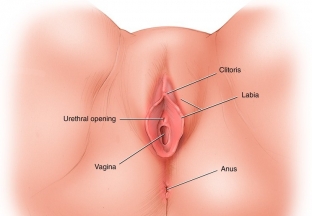Itching of the external genital organs greatly spoils the physical and moral condition of a woman. Unfortunately, itching is very common regarding the genitals of a woman. The causes of itching are varied. One of them is vulvitis.
Vulvitis is an inflammation of the external genital organs of a woman. As a rule, vulvitis is a rare occurrence for women of reproductive age. This is due to the peculiarities of the epithelial cover of the vulva. The main causes, symptoms and methods of treatment, as well as the differentiation of the diagnosis, read on estet-portal.com
Factors that contribute to inflammation of the vulva
For the occurrence of inflammation of the vulva in women of reproductive age, factors contributing to this are required:
- Pathological exudate in the vagina with endocervicitis and colpitis, which leads to maceration of the skin of the external genital organs and inflammation of the vulva.
- Contamination of the skin of the vulva with urine, especially in diabetic patients.
- Traumatization of the skin of the vulva during rough sexual intercourse.
- Scratching of the skin of the vulva due to irritation with pinworms in case of helminthiasis.
- Excessive sweating in the perineal region in obese women with a tendency to macerate and rub the skin.
- Non-compliance with hygiene of the genital organs as a result of pyoderma, furunculosis, folliculitis.
- Irritation of the skin of the vulva with infected urine in pyelonephritis, cystitis, urogenital fistulas.
- Prolonged exposure to mechanical, allergic, chemical and thermal factors on the vulva area.
With vulvitis in women with bakposev, anaerobic flora is noted - gram-positive flora in the foci of inflammation. But enterobacteria always predominate due to the anatomical proximity of the anus.
Clinical picture of vulvitis in women
The course of vulvitis can be acute, subacute and chronic.
- in acute vulvitis, the labia minora and labia majora, the clitoris, and the vaginal vestibule are edematous and hyperemic. The skin of the vulva is covered with a mucopurulent coating, provoking synechia of the labia. In this case, patients complain of itching, burning and pain in the perineum, especially when urinating. Often these symptoms are accompanied by an increase in inguinal lymph nodes and fever.
- in subacute vulvitis, the inflammation is not so pronounced. General intoxication is absent or mild. On examination, there is slight hyperemia and swelling of the skin, pastosity, pain on palpation.
- chronic course of vulvitis develops due to changes in the etiological factor of the disease. The most common causes of its chronic course are cytomegalovirus, chlamydial, herpes, ureaplasma infections.

The impact of vulvitis on the reproductive function of a woman
Vulvitis, although rare in young women who take care of themselves, nevertheless it occurs and affects the further reproductive health of a woman.
- Vulvitis in the untreated chronic form is often a source of ascending infection of the female genital organs (salpingoophoritis, colpitis, cervicitis, endometritis).
- Prolonged presence of sensations such as pain, burning and itching limit a woman's sexual activity.
- Women with chronic vulvitis during pregnancy often have problems - miscarriage, pyelonephritis of pregnant women, polyhydramnios, anomalies in labor, placental attachment pathologies, chorioamnionitis. Purulent-septic complications are possible in the postpartum period.
- It has been established that long-term persistent vulvitis is a focus of infection during intrauterine infection of the fetus, causing diseases in the unborn child.
- The constant itching of the vulva is very disturbing to the woman, disturbing her psyche.
Do not forget that itching of the vulva can appear with some extragenital pathologies: diabetes mellitus, glomerulonephritis with impaired renal function and azotemia, hepatitis, beriberi, with parasitic and fungal diseases. Also, itching can be triggered by hormonal disorders in menopause and menopause, which is associated with a drop in estrogen levels. At the same time, trophic processes in the tissues of the genital organs are disrupted.
What is the difference between vulvitis
Particular attention deserves the processes in the tissues of the external genital organs, when there are long-term chronically recurrent inflammatory processes. With these diseases it is necessary to differentiate vulvitis. This is leukoplakia and kraurosis.
Leukoplakia – in this disease, the stratified squamous epithelium proliferates excessively, and its maturation processes are disrupted. Leukoplakia can be recognized by seeing dry, whitish plaques with a pearly sheen that are taller than adjacent tissues. Often leukoplakia is located on the labia minora and on the clitoris. With the progression of the process, these neoplasms ulcerate and thicken.
Kraurosis of the vulva – manifested by atrophic tissue changes. At the same time, the skin of the vulva has a whitish, almost parchment-like appearance. When kraurosis expressed telangiectasia, atrophic skin. The mucous membranes are dry, brittle, depigmented and easily injured. In 20-50% of cases, against the background of these diseases, cancer of the external genitalia develops.
Complications, diagnosis and treatment of vulvitis in women
With a long course of vulvitis, condylomatosis of the external genital organs is a frequent complication.
Diagnosis of vulvitis is multi-stage: based on complaints, clinical picture, bacterioscopic and bacteriological studies.
Treatment of vulvitis should be complex, that is, drugs of general and local action are prescribed. Therapy is directed at the cause. Anti-inflammatory treatment includes antibacterial drugs of general and local action with a clearly established infectious nature during the diagnosis, desensitizing agents, hormonal drugs (in the elderly).
Watching her health in general, having sufficient personal hygiene, a woman may not be aware of such a problem as vulvitis. If vulvitis is detected, it must be differentiated from leukoplakia and kraurosis, and treated immediately to avoid the undesirable consequences of vulvitis.







Add a comment